
- •Лекция 1. Fundamental concepts of electromagnetics. Electrostatics. (Начало электростатики)
- •Vectors and scalar fields. (Векторные и скалярные поля)
- •Electrostatic field. (Электростатическое поле)
- •Coulomb’s Law. (Закон Кулона)
- •Electric Field Strength e and Displacement Field d. (Напряжённость и смещение электрического поля)
- •Gauss’ Law. (Закон Гаусса)
- •Electric Potential. (Электрический потенциал)
- •Work in the electric field. (Работа в электрическом поле)
- •Dielectric polarization. (Диэлектрическая поляризация)
- •Dielectric material characteristics. (Характеристики диэлектриков)
- •Properties of dielectric materials. (Свойства диэлектрических материалов)
- •Poisson’s and Laplace’ s equations. (Уравнения Пуассона и Лапласа)
- •Лекция 2. Boundary conditions for the Laplace or Poisson equations (Граничные уравнения для уравнений Лапласа и Пуассона)
- •Electrostatic Energy (Электростатическая энергия)
- •Virtual experiment. (Эксперимент по нахождению энергии системы)
- •Consequences (Следствия)
- •Continuity Equation (Уравнение непрерывности)
- •Лекция 3. Static magnetic field (Статическое магнитное поле)
- •Variables and units (Переменные и единицы измерения)
- •Main Relations (Основные соотношения)
- •Magnetic flux density (Индукция магнитного поля)
- •Biot-Savart’s law (Закон Био-Савара)
- •Ampere’s law (Закон полного тока)
- •Scalar magnetic potential (Скалярный магнитный потенциал)
- •The cut in the space (Разрез в пространстве)
- •Laplace equation for the scalar magnetic potential (Уравнение Лапласа для скалярного магнитного потенциала)
- •Vector magnetic potential (Векторный магнитный потенциал)
- •Magnetic flux (Магнитный поток)
- •Differential equation for the vector magnetic potential (Дифференциальное уравнение для векторного магнитного потенциала)
- •Gauging of the vector magnetic potential (Калибровка векторного магнитного потенциала)
- •Integral presentation of the vector magnetic potential (Интегральное представление векторного потенциала)
- •Inductance (Индуктивность)
- •Mutual inductance (Взаимная индуктивность)
- •Inductance of thin contours (Индуктивность тонких контуров)
- •Field intensity inside a cylindrical conductor (Напряжённость поля внутри цилиндрического проводника)
- •Лекция 4. Method of images (метод зеркальных изображений)
- •Equivalent charge density (эквивалентная плотность заряда)
- •Method of images for cylindrical boundaries between dielectrics (метод изображений цилиндрических границ между диэлектриками) Problem formulation (постановка задачи)
- •The inverse point (обратная точка)
- •Normal component of the field intensity (нормальная составляющая напряжённости поля)
- •Geometrical relations (геометрические соотношения)
- •Angles (углы)
- •Field induced by the line sources (поле, индуцированное линейными источниками)
- •The field sources for the external domain (источники полей для внешней области)
- •The field sources for the internal domain (источники полей для внутренней области)
- •Image method for the flat boundary between magnetic media (Метод изображений для плоской границы между магнитными носителями)
- •Equivalent magnetic charge density (Эквивалентная плотность магнитного заряда)
- •Dependence of the field intensity on the coordinate (Зависимость напряжённости поля от координаты)
- •Inductance of the two-wire transmission line per unit length (Индуктивность двухпроводной линии передачи на единицу длины)
- •Total inductance (Общая индуктивность)
- •Forces. The first line. (Силы. 1ая линия)
- •Forces. The second line. (Силы. 2ая линия)
- •Лекция 5. Solution of Laplace’s equation by separation of variables. (Решение уравнения Лапласа методом разделения переменных) Application of Laplace’s equation (Применение уравнения Лапласа).
- •Choice of a coordinate system (Выбор системы координат)
- •Variable separation in cylindrical coordinates (Разделение переменных в цилиндрических координатах)
- •Angular function (Угловая функция)
- •Radial function (Радиальная функция)
- •General solution of the Laplace’s equation in a cylindrical coordinate system (Общее решение уравнения Лапласа в цилиндрической системе координат)
- •Application of the variable separation method for the magnetic field modeling (Применение метода разделения переменных для моделирования магнитного поля)
- •Reduced scalar magnetic potential (Редуцированный скалярный магнитный потенциал)
- •Combination of scalar magnetic potential and reduced magnetic potential (Комбинация скалярного магнитного потенциала и редуцированного магнитного потенциала)
- •The scalar potential induced by the current line (Скалярный потенциал, индуцируемый линией тока)
- •The current potential in the cylindrical coordinate system (Потенциал от линии с током в цилиндрической системе координат)
- •The current potential in the complex plane (Потенциал от линии с током в комплексной плоскости)
- •Expansion of the current potential in the cylindrical coordinate system (Разложение потенциала от линии с током в цилиндрической системе координат)
- •Potentials in the problem domain (Потенциалы в проблемной области)
- •Inductance of the two-wire transmission line per unit length (Индуктивность двухпроводной линии передачи на единицу длины)
- •The flux induced by the magnetized cylinder (Поток, индуцируемый намагниченным цилиндром)
- •Лекция 6. Time dependent electromagnetic fields (Зависящие от времени электрические поля)
- •Faraday’s Law (Закон электромагнитной индукции)
- •Lenz’s Law (правило Ленца)
- •Induction by a temporal change of b (Индукция за счёт временного изменения b)
- •Induction through the motion of the conductor (Индукция за счёт движения проводника)
- •Induction by simultaneous temporal change of b and motion of the conductor (Индукция одновременным изменением во времени b и движением проводника)
- •Unipolar generator (Униполярный генератор)
- •Hering’s paradox (Парадокс Геринга)
- •Periodic electromagnetic field in the conductors. (Периодическое электромагнитное поле в проводниках)
- •Penetration of the electromagnetic field into a conductor. (Проникновение электромагнитного поля в проводник)
- •The skin effect. (Скин-эффект)
- •Poynting’s Theorem. (Теорема Пойнтинга) Electromagnetic Field Energy. (Энергия электромагнитного поля)
- •The rate of decrease of the electromagnetic field energy in a closed volume. (Скорость уменьшения энергии электромагнитного поля в замкнутом объёме)
- •Energy flows in the electromagnetic field (Поток энергии в электромагнитном поле)
- •Transmission of energy in a dc line (Передача энергии в линиях постоянного тока)
- •Transmission of energy in a dc line (Передача энергии в линиях постоянного тока)
- •The field picture near the wires with current (Картина поля вблизи провода с током)
- •Energy flows in static fields (Поток энергии в статических полях)
- •The momentum of the electromagnetic field (Момент электромагнитного поля)
- •The momentum of the electromagnetic field (Момент электромагнитного поля)
- •Лекция 8. Numerical Methods of the Electromagnetic Field Modeling. (Численные методы моделирования электромагнитного поля) Classification of the numerical methods (Классификация численных методов)
- •Classification of the problems (Классификация проблем)
- •Classification of the methods (Классификация методов)
- •Method of moments (Метод моментов)
- •Discretization of the problem domain (Дискретизация проблемной области)
- •Algebraic equation system (Алгебраическая система уравнений)
- •Finite element method (Метод конечных элементов)
- •Discretization (Дискретизация)
- •Finite functions (Ограниченная функция – отлична от нуля только в пределах треугольника)
- •Approximation of functions inside triangles (Аппроксимация функций внутри треугольника)
- •Approximation of the equation (Аппроксимация уравнения)
- •Weighted residual method (метод взвешенных невязок)
- •Galerkin method (метод Бубнова-Галеркина)
- •Weak formulation (ослабленная формулировка)
- •First type boundary conditions (Первый тип граничных условий)
- •The potential and field intensity (Потенциал и напряжённость поля)
Hering’s paradox (Парадокс Геринга)
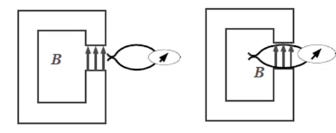 We
shall consider a magnet that is c-shape magnet. The magnetic field is
induced in the gap of the magnet, it may be induced by the
electromagnet, it means there should be coil which induces the
magnetic field. What is the experiment? The magnet without leakage.
The magnetic flux density lines goуы
around the ferromagnetic core, then these lines leave the core just
at this surface. Then they go parallel to each other to the opposite
side of the ferromagnetic core. The coil and the amperemeter are
placed far from this magnet and somebody take this system and start
to move to the magnet. In the beginning the amperemeter or voltmeter
demonstrates nothing, but then when it cross magnetic field, the EMF
is induced in this contour and detector just demonstrates us
something happened to the voltage or current are induced in this
contour. Outside the magnet, there is a conducting loop with elastic
contacts that ensure a closed circuit at all times. The circuit also
induces a voltmeter.
We
shall consider a magnet that is c-shape magnet. The magnetic field is
induced in the gap of the magnet, it may be induced by the
electromagnet, it means there should be coil which induces the
magnetic field. What is the experiment? The magnet without leakage.
The magnetic flux density lines goуы
around the ferromagnetic core, then these lines leave the core just
at this surface. Then they go parallel to each other to the opposite
side of the ferromagnetic core. The coil and the amperemeter are
placed far from this magnet and somebody take this system and start
to move to the magnet. In the beginning the amperemeter or voltmeter
demonstrates nothing, but then when it cross magnetic field, the EMF
is induced in this contour and detector just demonstrates us
something happened to the voltage or current are induced in this
contour. Outside the magnet, there is a conducting loop with elastic
contacts that ensure a closed circuit at all times. The circuit also
induces a voltmeter.
T![]() hen
we started move the coil down. In such a case our voltmeter shows
nothing, because magnetic flux which is linked with this contour is
constant.
hen
we started move the coil down. In such a case our voltmeter shows
nothing, because magnetic flux which is linked with this contour is
constant.
Movement of the coil causes a voltage impulse:
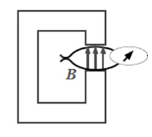
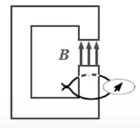
So, we move contour from this position to that one
T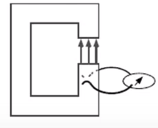 hen,
we're taking this contour this magnetic system and started to move
outside the magnet. In such a case this spring (пружинка)
contacts now nevertheless forms a closed circuit. Now closed circuit
starts here (на картинке).
It passes through the voltmeter or amperemeter, then comes to the
opposite side of the core, this is spring contact with iron core. We
moved outside, then at the exit this spring again comes to each other
and forms a closed contour.
hen,
we're taking this contour this magnetic system and started to move
outside the magnet. In such a case this spring (пружинка)
contacts now nevertheless forms a closed circuit. Now closed circuit
starts here (на картинке).
It passes through the voltmeter or amperemeter, then comes to the
opposite side of the core, this is spring contact with iron core. We
moved outside, then at the exit this spring again comes to each other
and forms a closed contour.
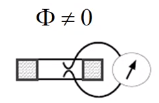 It's
shown here what is going on: in the beginning this spring contact
form this contour
It's
shown here what is going on: in the beginning this spring contact
form this contour

Then they contact only the core, nevertheless there is the contour here
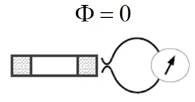
Finally, again form a closed circuit
I![]() f
we shall consider this situation from the opposite side, from the
formulation of the Faraday's Law which deals with the moving
conductors, then it may be understandable. When we move this
conductor (На первой
картинке, где
Ф не равно
0) with this spring contact, we see here contact moves, but there is
no magnetic field here, that is why equal to zero.
f
we shall consider this situation from the opposite side, from the
formulation of the Faraday's Law which deals with the moving
conductors, then it may be understandable. When we move this
conductor (На первой
картинке, где
Ф не равно
0) with this spring contact, we see here contact moves, but there is
no magnetic field here, that is why equal to zero.
Now, in this system (вторая картинка) there is no field outside the core, that is why this spring contact moves, but they aren't in the magnetic field, that is why the electric field is not induced inside this contacts and inside the wires which connect these contacts with the detector. About this inner part of the core, this part doesn't move, there is a magnetic field and strong magnetic field inside, but the velocity equal to zero, that is why the field intensity not induces inside. So, from this point it's clear, they shouldn't be electric field at all, they shouldn't be induced EMF. And the experiment demonstrate - there is no induced EMF.
This may appear a paradox which represents a contradiction to Faraday's Law. Essential is, however, that the flux change is not related to the motion of the conductor.
I![]() nside
the magnet: field exists but there is no movement.
nside
the magnet: field exists but there is no movement.
Outside the magnet: conductor moves, but there is no field.
Лекция 7. Time dependent electromagnetic fields. (Зависящие от времени электрические поля)
Diffusion of electromagnetic fields in conducting media. (Распространение электромагнитного поля в проводящей среде)
When we shall talk about this topic, we shall assume, that’s we have conducting media, usually, it’s metal. And the electromagnetic field satisfies the Faraday’s Law and the Ampere’s Law. The specific feature of this fields is there are no displacement currents. That’s usual situation in conductors, sometimes even in conductors the displacement currents are taken into account. That is a case, which we called bad conductors. But today we shall neglect them. Inside in conducting medium there are no displacement currents and there are no free charges. In such a case the electromagnetic fields may be described by several equations:
The Faraday’s Law: |
|
In this case this is conductivity current, which may be described by the Ohm’s Law: |
|
|
|
Also, the electric and the magnetic fields satisfies the Gauss’s Law (for the magnetic field it’s a universal law, so it takes place in any case. In the case of electric field, it’s some special case: divE=0 only in a free charge medium (это следствие из divD=0)): |
|
The First Kirchhoff’s Law: |
|
|
|
Let’s make some transformations with these equations:
Differential equations for the electric field intensity:

Mathematical transformation:
Diffusion equations for the electromagnetic field characteristics:
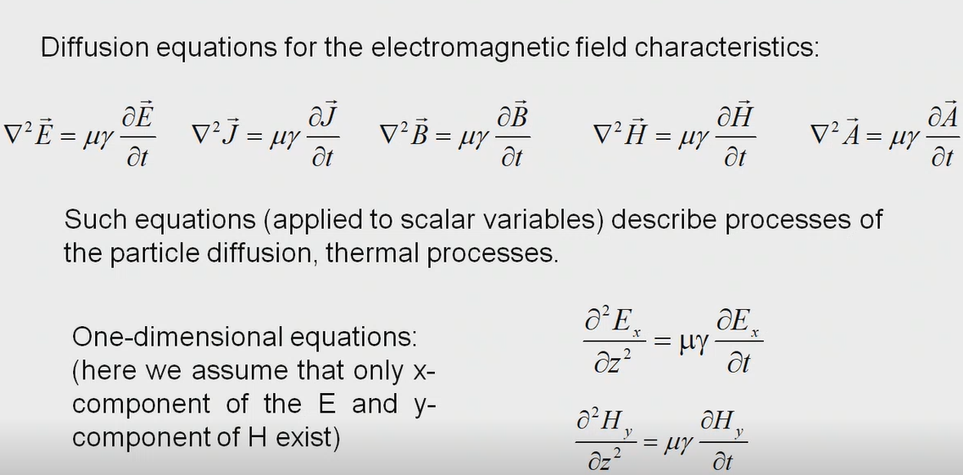
Such equations (applied to scaler variables) describe processes of the particle diffusion, thermal processes.
One-dimensional equations: (here we assume that only x-component of the E and y-component of H exist) |
|



